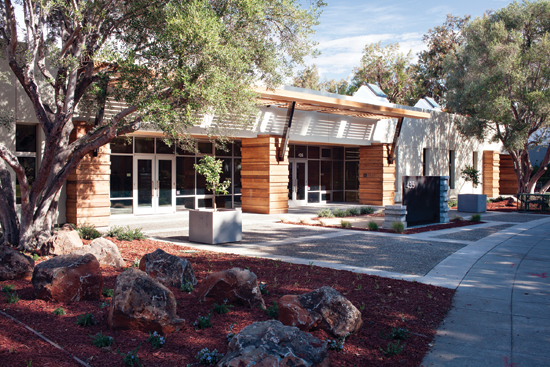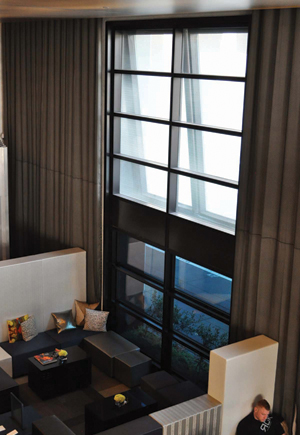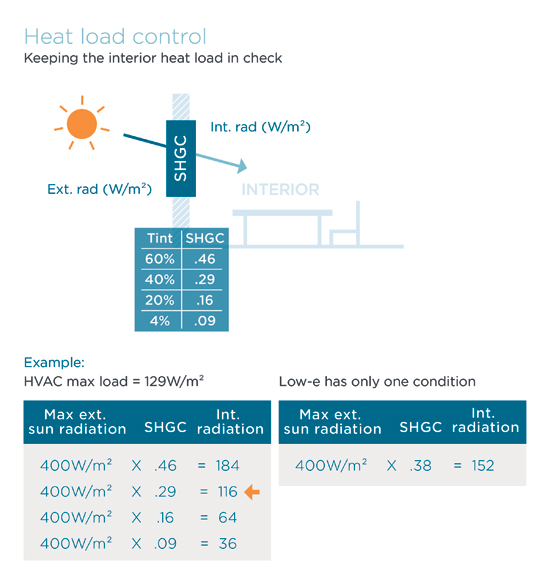The Move to Dynamic Glass
Advanced dynamic glass can deliver separate tint levels, corresponding to less than 4, 20, and more than 60 percent visible light transmittance (Tvis) with other tint levels available as required. In its fully tinted state, building occupants can block out heat and manage glare while still seeing through the glass for an unobstructed view of the outside world.
The technology allows for control of individual windows or coordinated groups of windows. With a grouping capability, zones can be created to tailor the behavior of the glass for spaces with different uses or even within a single façade for optimal daylighting. For example, in a curtain wall design, the top course of vision glass could be set to 20 percent Tvis, admitting light for daylighting purposes, while the remaining eye-level glass can be set for a darker tint to decrease glare.
With this zoning capability, dynamic glass control can be integrated into building management systems, or be controlled from a tablet or smart phone.
Technologies
Not all dynamic glass functions the same way. Examples of technologies that enable smart windows include electrochromic (EC), thermochromic, photochromic, liquid crystal (LC) and suspended particle devices (SPD). Thermochromic and photochromic technologies change their properties based on ambient temperature and ambient light levels respectively. They are commonly termed “passive” dynamic technologies. EC, LC and SPD technologies have the advantage of active electronic control of glass performance, enabling truly intelligent controls that can be integrated with occupant schedules, lighting levels, or algorithms to increase building energy efficiency. Both LC and SPD require continuous high-voltage AC power to operate, and their failure mode is to a dark state. EC technology has the advantage of using low voltage, has very low energy consumption, and has a power off mode that is neutral or clear.
For EC glass, multiple thin layers of metal oxide form the electrochromic component on the inside of the glass. In the absence of a voltage, the metal oxide film is completely transparent. With the application of a 5-volt electrical charge, the ions in EC glass move between layers, changing its properties and tinting the glass. The darker the tint, the more solar radiation and glare are rejected, resulting in temperature and energy control. The coating itself has the low emissivity benefits similar to traditional low-e glass, enhancing the thermal performance when combined into a dual pane insulting glass unit. The application of EC technology to windows can substantially reduce the energy consumption of buildings by reducing cooling and heating loads as well as the demand for electric lighting. Among the aforementioned smart window technologies, EC is the only one to have passed the ASTM standard for accelerated environmental durability, which designates a 50-year service life.
 |
The application of EC technology to windows can substantially reduce the energy consumption of buildings by reducing cooling and heating loads as well as the demand for electric lighting. Photo courtesy of View Inc. |
Intelligence
 |
Since dynamic glass is intelligent and can change, it can adjust to the outside world, to provide optimum natural light and comfort, no matter what the conditions or time of year. Photo courtesy of View Inc. |
While the glass provides the tint, the system makes it intelligent. Predictive intelligence foresees the sun's movement and automatically adjusts each window's tint to anticipate the sun's solar load. The same intelligence then adjusts the tint level according to location, space type, weather, and user preference. Each window has local intelligence and knows its unique position, orientation, and condition. As a result, the intelligence function seamlessly manages direct glare on occupants while maintaining the architect's intended views. As inputs to the intelligence function, several project parameters are required, including the following:
• Building location and orientation sunpath
• Exterior building characteristics
• Interior space design
• Maximum heat load allowed
• Sensors
In practical terms, the dynamic glass manufacturer collects the required project parameters from blueprints and site visits, building up a database for each project. A building's longitude and latitude will be noted as will sun location coordinates and sun radiation year-round. Zoning will be taken into account as well as window measurements, interior measurements, and the building's maximum heat loads and sensor inputs.
Intelligence computes in the following three ways:
Glare control. Intelligence calculates the angle of the sun and determines if there is glare on occupants, and tints the window down if necessary.
Heat load control. The heat load of the space is managed to be lower than peak solar heat gain design load and associated HVAC design, and daylight is maximized. Based on maximum radiation for a particular façade for a specific time and day, intelligence will determine the necessary tint state to keep heat gain below peak/maximum. As shown in the accompanying figure (see the online version of this course), Max Inside Radiation = Max sun radiation * SHGC of glass. Intelligence tints glass down as needed to keep heat generated by the sun in the room below the design maximum. With this control, the building's peak load will be reduced compared to a baseline design using static glass. The dynamic glass design therefore requires a smaller building HVAC system.
 |
|
Image courtesy of View Inc. |









